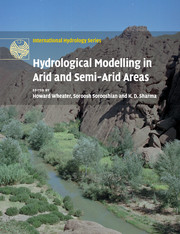Book contents
- Frontmatter
- Contents
- List of contributors
- Preface
- Acknowledgements
- 1 Modelling hydrological processes in arid and semi-arid areas: an introduction
- 2 Global precipitation estimation from satellite imagery using artificial neural networks
- 3 Modelling semi-arid and arid hydrology and water resources: The southern Africa experience
- 4 Use of the IHACRES rainfall-runoff model in arid and semi-arid regions
- 5 KINEROS2 and the AGWA modelling Framework
- 6 Ephemeral flow and sediment delivery modelling in the Indian arid zone
- 7 The modular modelling system (MMS): a toolbox for water and environmental resources management
- 8 Calibration, uncertainty, and regional analysis of conceptual rainfall-runoff models
- 9 Real-time flow forecasting
- 10 Real-time flood forecasting: Indian experience
- 11 Groundwater modelling in hard-rock terrain in semi-arid areas: experience from India
- Appendix Access to software and data products
- Index
- Plate section
- References
10 - Real-time flood forecasting: Indian experience
Published online by Cambridge University Press: 15 December 2009
- Frontmatter
- Contents
- List of contributors
- Preface
- Acknowledgements
- 1 Modelling hydrological processes in arid and semi-arid areas: an introduction
- 2 Global precipitation estimation from satellite imagery using artificial neural networks
- 3 Modelling semi-arid and arid hydrology and water resources: The southern Africa experience
- 4 Use of the IHACRES rainfall-runoff model in arid and semi-arid regions
- 5 KINEROS2 and the AGWA modelling Framework
- 6 Ephemeral flow and sediment delivery modelling in the Indian arid zone
- 7 The modular modelling system (MMS): a toolbox for water and environmental resources management
- 8 Calibration, uncertainty, and regional analysis of conceptual rainfall-runoff models
- 9 Real-time flow forecasting
- 10 Real-time flood forecasting: Indian experience
- 11 Groundwater modelling in hard-rock terrain in semi-arid areas: experience from India
- Appendix Access to software and data products
- Index
- Plate section
- References
Summary
INTRODUCTION
Since time immemorial, floods have been responsible for loss of crops and valuable property, and untold human misery in the world. India has been no exception. An area of more than 40 million ha in India has been identified as flood prone. India, which is traversed by a large number of river systems, experiences seasonal floods. It has been the experience that floods occur almost every year in one part or the other of the country. The rivers of north and central India are prone to frequent floods during the south-west Monsoon season, particularly in the months of July, August, and September. In the Brahmaputra river basin, floods have often been experienced as early as in late May while in southern rivers floods continue till November. On average, floods in India have affected about 33 million persons between 1953 and 2000. There is every possibility that this figure may increase due to population growth and development in the flood plains.
Floods occur due to natural as well as man-made causes. Major causes of floods in India include intense precipitation, inadequate capacity within riverbanks to contain high flows, and silting of riverbeds. In addition, other factors are land slides leading to obstruction of flow and changes in the river course, retardation of flow due to tidal and backwater effects, poor natural drainage, cyclone and heavy rainstorms/cloud bursts, snowmelt and glacial outbursts, and dam-break flow.
For minimizing the losses due to floods, various flood control measures are adopted.
Information
- Type
- Chapter
- Information
- Hydrological Modelling in Arid and Semi-Arid Areas , pp. 139 - 156Publisher: Cambridge University PressPrint publication year: 2007
References
Accessibility standard: Unknown
Why this information is here
This section outlines the accessibility features of this content - including support for screen readers, full keyboard navigation and high-contrast display options. This may not be relevant for you.Accessibility Information
- 2
- Cited by
